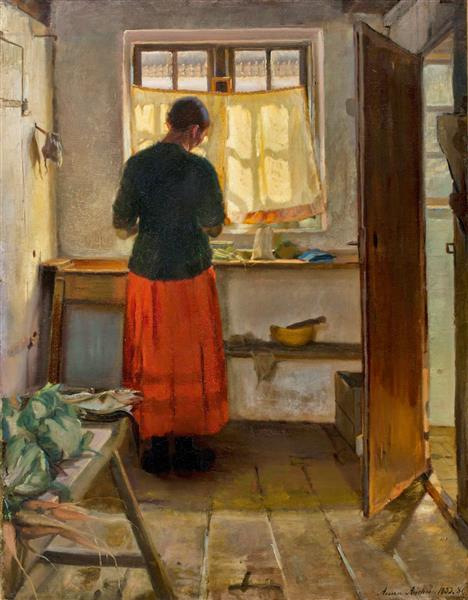Description
The work "The maid in the kitchen" by Anna Ancher, painted in 1886, is an outstanding example of Nordic realism, where attention to detail and the intimate representation of everyday life becomes prominent. Ancher, one of the few women artists recognized in his time, carried out a remarkable career in the Skagen movement, which focused on the life and customs of the fishing community in northern Denmark. His ability to capture light and atmosphere has left a mark on the history of Danish art.
At first glance, the painting presents a scene that seems simple, but that actually contains an emotional and psychological depth. The context is a kitchen illuminated by the natural light that is filtered through a window. In the center of the composition is a young maid, dressed in apron and a period dress, which is accommodated at a wooden table where the task of peeling potatoes is dispensed. Her concentrated gesture moves her away from the viewer, suggesting an almost meditative dedication to her work. This choice of the female figure as the protagonist in a daily activity resonates with the impulse of Ancher to honor domestic work, which, often, was invisible in the art of his time.
The use of color in "The maid in the kitchen" is especially notable. Ancher applies a warm palette that goes from the golden and terracotta tones on the walls and furniture, to the chiaroscuros that give volume to the figure of the young woman. The soft and warm light illuminates the scene, creating a cozy and reassuring atmosphere that reflects the intimacy of the kitchen, a space that, in the Danish culture, symbolizes the home. The resolution through light and shadow is effective, not only to confer a sense of depth, but also to direct attention to the work of the protagonist.
In addition, the perspective used by Ancher offers an almost intimate vision, where the viewer can almost feel the warmth of the kitchen and the friction of the air. The distribution of the space is carefully balanced, with the young woman located at the angle, allowing the viewer's eyes to move through the composition without any distraction. The metaphor of the home is intrinsically linked to the sense of belonging and hard work, which makes this painting a powerful hymn to women of their time, often relegated under the shadow of a patriarchal society.
It is essential to mention that Ancher, throughout his career, worked with the theme of the home and domestic work on several occasions, as can be seen in other contemporary works that represent the lives of women in the family environment. However, in "the maid in the kitchen", a unique connection is achieved between the female figure and the environment, as well as an almost palpable introspection of daily life, which allows viewers to pause and reflect on work and the value that lives in it.
Anna Ancher's legacy resonates not only in the field of Danish art, but also invites the revaluation of everyday life through an artistic lens. His ability to portray the lives of women and their domestic environment continues to inspire and challenge the perception of the role of women in art history. "The maid in the kitchen" is, therefore, rooted in a tradition that goes beyond a simple representation and becomes a testimony of female experience in the nineteenth century, capturing a moment that smells of history and life in the middle of everyday life.
KUADROS ©, a famous paint on your wall.
Hand-made oil painting reproductions, with the quality of professional artists and the distinctive seal of KUADROS ©.
Art reproduction service with satisfaction guarantee. If you are not completely satisfied with the replica of your painting, we refund your money 100%.

